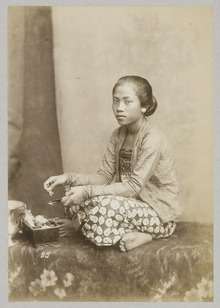Menginang

Bersirih, nyirih or menginang is a Malay-Indonesian tradition of chewing materials such as nut, betel, gambier, tobacco, clove and limestone.[1] Menginang tradition or chewing betel nut is widespread among Indonesian ethnic groups, especially among Javanese, Balinese and Malay, and it dates back to more than 3000 years.[2] Records of travelers from China showed that betel and areca had been consumed since the 2nd century BC.[2]
Ingredients
Ingredients of menginang includes nut, betel, gambier, tobacco, clove and limestone.[1] Its contents, especially areca nut with addition of tobacco, has a mild stimulant effects,[3] inducing an addictive psychostimulating euphoria.
Equipments

A complete and elaborate set of sirih pinang equipments is called Tepak Sirih, Pekinangan or Cerana. It is made of wooden lacquerware, brass or silverwares and consists of combol (containers), bekas sirih (leaf container), kacip (press-knive to cut areca nut), gobek (small pestle and mortar), and ketur (spit container).[1] It was said that Sirih Pinang has become a symbol of Malay culture.[4]
Tradition

In Malay archipelago, the menginang or betel nut chewing has become a revered activity in local tradition; as it has become a ceremoniously conducted gesture to honor a guest. The Malay oral tradition uses phrases such as "Betel door opener home", "Betel door opener heart".[4] Menginang is used at many formal occasions such as marriages, births, deaths, and healings.[5] Numbers of Malay traditional dances — such as South Sumatran Tanggai dance, are in fact describing the dancers bringing cerana or tepak sirih equipment and ceremoniously present an offering of betel nut to the revered guest.
References
- 1 2 3 "Tradisi Bersirih dan Nilai Budayanya". MelayuOnline.com. Retrieved 5 May 2014.
- 1 2 "Menginang, Cikal Bakal Tradisi Kretek Nusantara". Kompasiana.com. Retrieved 5 May 2014.
- ↑ "Betelnut - stimulant".
- 1 2 "Menginang adalah". Academia.edu. Retrieved 13 May 2014.
- ↑ "Filosofi Menginang (Makan Pinang)". Jakarta.Kompasiana.com. Retrieved 5 May 2014.